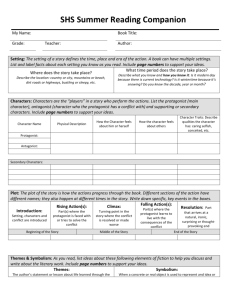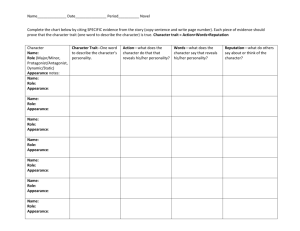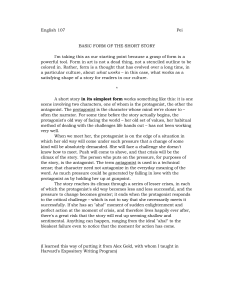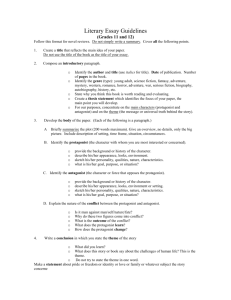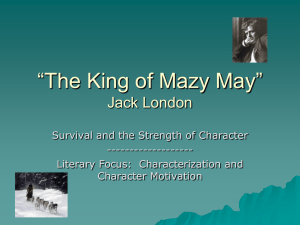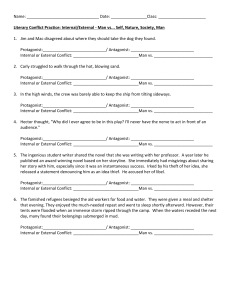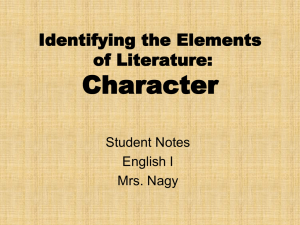File - Hassan Basarally
advertisement
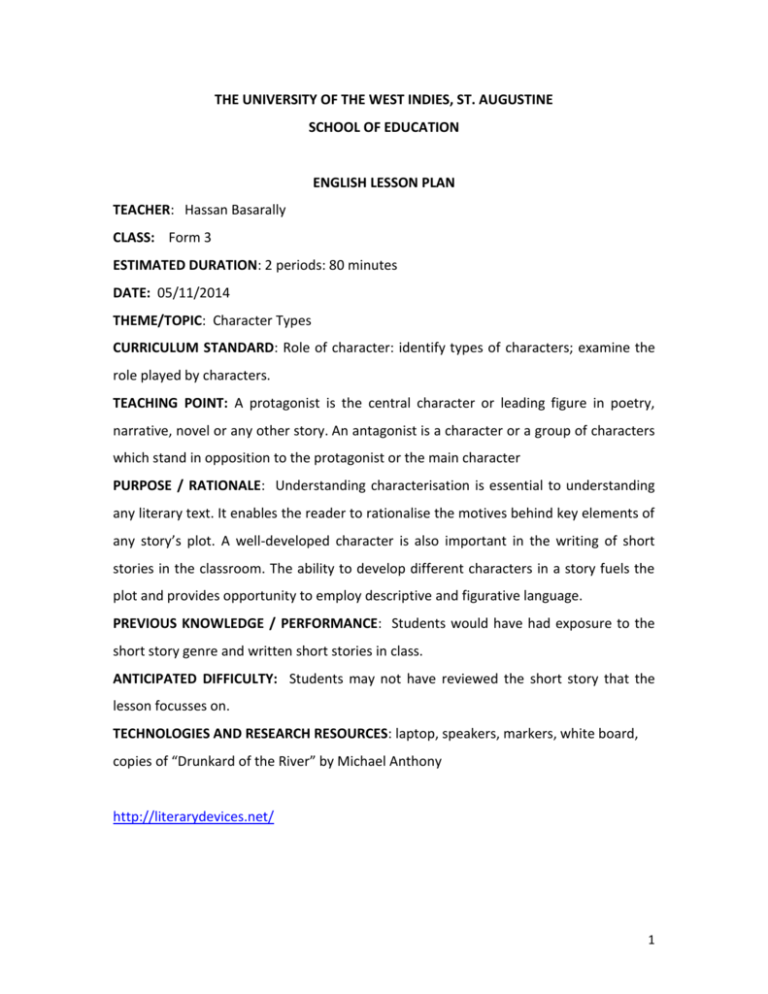
THE UNIVERSITY OF THE WEST INDIES, ST. AUGUSTINE SCHOOL OF EDUCATION ENGLISH LESSON PLAN TEACHER: Hassan Basarally CLASS: Form 3 ESTIMATED DURATION: 2 periods: 80 minutes DATE: 05/11/2014 THEME/TOPIC: Character Types CURRICULUM STANDARD: Role of character: identify types of characters; examine the role played by characters. TEACHING POINT: A protagonist is the central character or leading figure in poetry, narrative, novel or any other story. An antagonist is a character or a group of characters which stand in opposition to the protagonist or the main character PURPOSE / RATIONALE: Understanding characterisation is essential to understanding any literary text. It enables the reader to rationalise the motives behind key elements of any story’s plot. A well-developed character is also important in the writing of short stories in the classroom. The ability to develop different characters in a story fuels the plot and provides opportunity to employ descriptive and figurative language. PREVIOUS KNOWLEDGE / PERFORMANCE: Students would have had exposure to the short story genre and written short stories in class. ANTICIPATED DIFFICULTY: Students may not have reviewed the short story that the lesson focusses on. TECHNOLOGIES AND RESEARCH RESOURCES: laptop, speakers, markers, white board, copies of “Drunkard of the River” by Michael Anthony http://literarydevices.net/ 1 INSTRUCTIONAL OBJECTIVES (CLASSIFICATION) Students will / should be able to: 1. Define the term Protagonist and Antagonist. (cognitive) 2. Identify the protagonist and antagonist in literary texts. (cognitive) 3. Differentiate between a protagonist and antagonist. (cognitive) 4. Analyse characters in literary texts. (cognitive) 5. Explain the causes and consequences of characters’ actions in literary texts. (affective) ASSESSMENT Formative: Students will explain the reasons why characters in the selected texts can be considered a protagonist and antagonist. Students will take on the role of characters in the text to explain their actions and feelings seen in the story. Summative: Students will compare the characters by creating a character sketch. 2 PROCEDURE SET INDUCTION: The teacher displays a series of images on the projector, asking the students to identify each character. The teacher then asks the students what heading the previously shown characters can be placed under. TEACHING STRATEGIES/METHODS/ACTIVITIES LEARNING STRATEGIES/ACTIVITIES 1. The teacher asks the students to explain what Thinking and responding they understand a character to be. 2. The teacher explains that characters can be of different types and kinds. 3. The teacher introduces the term protagonist and explains what the prefix means. 4. The teacher shows students images of Thinking and responding protagonists from different stories and asks them to formulate a definition. 5. The teacher uses the student responses to create a definition. 6. The same procedure (3-5) is repeated for antagonist. 7. The teacher distributes copies of the story “Drunkard of the River” by Michael Anthony. 8. The class is divided into groups of three and asked to write down any three things they Group work Summarising remember from the story. 9. The teacher asks students to read selected Reading portions of the story to refresh their memory 10. The students are asked to choose the two most Responding to questions important characters from the story and explain why. 3 11. The students are asked to choose which Thinking and responding character they will define as the protagonist and antagonist respectively. 12. The teacher draws a table on the board and lists the reasons given. 13. The teacher asks for volunteers to act the role Role play of selected characters in the story to do an interview. 14. The teacher draws another table on the board Thinking and responding and asks students to explains what they have learns about the protagonist and antagonist respectively. 15. Students are asked to draw the table in their books. CLOSURE: Students are asked to define a protagonist and antagonist and give examples from literature or popular culture. LESSON EVALUATION: Students are asked to take the role of the author and write a paragraph of what happens to Mano after the story ends. These will be collected and read to the class or completed for homework. CONTINGENCY PLAN: Prints of the characters to be used as examples will be made and shown to students. TEACHER’S EVALUATION OF THE LESSON: SUPERVISOR’S COMMENTS: 4
